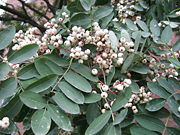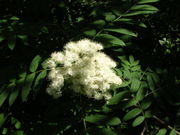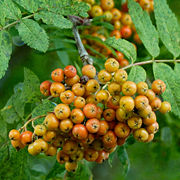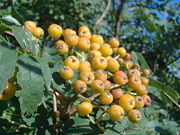Rowan
2008/9 Schools Wikipedia Selection. Related subjects: Plants
| Rowan | ||||||||||||||||
|---|---|---|---|---|---|---|---|---|---|---|---|---|---|---|---|---|
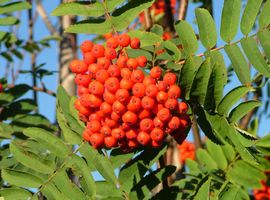 European Rowan fruit
|
||||||||||||||||
| Scientific classification | ||||||||||||||||
|
||||||||||||||||
| Species | ||||||||||||||||
|
Sorbus subgenus Sorbus |
The rowans are plants in the family Rosaceae, in the genus Sorbus, subgenus Sorbus. They are native throughout the cool temperate regions of the Northern Hemisphere, with the highest species diversity in the mountains of western China and the Himalaya, where numerous apomictic microspecies occur.
Botany
Rowans are mostly small deciduous trees 10-20 m tall, though a few are shrubs. The leaves are arranged alternately, and are pinnate, with (7-)11-35 leaflets; a terminal leaflet is always present. The flowers are borne in dense corymbs; each flower is creamy white, and 5-10 mm across with five petals. The fruit is a small pome 4-8 mm diameter, bright orange or red in most species, but pink, yellow or white in some Asian species. The fruit are soft and juicy, which makes them a very good food for birds, particularly waxwings and thrushes, which then distribute the rowan seeds in their droppings.
Rowan is used as a food plant by the larvae of some Lepidoptera species; see Lepidoptera that feed on Sorbus.
The best-known species is the European Rowan Sorbus aucuparia, a small tree typically 4-12 m tall growing in a variety of habitats throughout northern Europe and in mountains in southern Europe and southwest Asia. Its berries are a favourite food for many birds and are a traditional wild-collected food in Britain and Scandinavia. It is one of the hardiest European trees, occurring to 71° north in Vardø in Arctic Norway, and has also become widely naturalised in northern North America.
The greatest diversity of form as well as the largest number of species is in Asia, with very distinctive species such as Sargent's Rowan Sorbus sargentiana with large leaves 20-35 cm long and 15-20 cm broad and very large corymbs with 200-500 flowers, and at the other extreme, Small-leaf Rowan Sorbus microphylla with leaves 8-12 cm long and 2.5-3 cm broad. While most are trees, the Dwarf Rowan Sorbus reducta is a low shrub to 50 cm tall. Several of the Asian species are widely cultivated as ornamental trees.
North American native rowans include the American mountain-ash Sorbus americana and Showy mountain-ash Sorbus decora in the east and Sitka mountain-ash Sorbus sitchensis in the west.
For other Sorbus species, see whitebeam (Sorbus subgenus Aria) and the genus article Sorbus. Numerous hybrids, mostly behaving as true species reproducing by apomixis, occur between rowans and whitebeams; these are variably intermediate between their parents but generally more resemble whitebeams and are usually grouped with them (q.v.).
Uses
Rowans are excellent small ornamental trees for parks, gardens and wildlife areas. Several of the Chinese species, such as White-fruited rowan (Sorbus glabrescens) are popular for their unusual berry colour, and Sargent's rowan (Sorbus sargentiana) for its exceptionally large clusters of fruit. Numerous cultivars have also been selected for garden use, several of them, such as the yellow-fruited Sorbus 'Joseph Rock', of hybrid origin. They are very attractive to fruit-eating birds, which is reflected in the old name "bird catcher". The wood is dense and used for carving and turning and for tool handles and walking sticks.
Rowan berries as food
The berries of European Rowan (Sorbus aucuparia) can be made into a slightly bitter jelly which in Britain is traditionally eaten as an accompaniment to game, and into jams and other preserves, on their own, or with other fruits. The berries can also be a substitute for coffee beans, and have many uses in alcoholic beverages: to flavour liqueurs and cordials, to produce country wine, and to flavour ale.
Rowan cultivars with superior fruit for human food use are available but not common; mostly the fruits are gathered from wild trees growing on public lands.
Rowan berries contain sorbic acid, an acid that takes its name from the Latin name of the genus Sorbus. Raw berries also contain parasorbic acid (about 0.4%-0.7% in the European rowan), which causes indigestion and can lead to kidney damage, but heat treatment ( cooking, heat- drying etc.) and, to a lesser extent, freezing, neutralises it, by changing it to the benign sorbic acid. Luckily, they are also usually too astringent to be palatable when raw. Collecting them after first frost (or putting in the freezer) cuts down on the bitter taste as well.
Folk-medicinal uses
Fresh rowan berry juice is usable as a laxative, gargle for sore throats, inflamed tonsils, hoarseness, and as a source of vitamins A and C. Rowan berry jam will remedy diarrhea. An infusion of the berries will benefit hemorrhoids and strangury. The bark can also be used as an astringent for loose bowels and vaginal irritations. Rowan is also used for eye irritations, spasmic pains in the uterus, heart/bladder problems, neuralgia, gout and waist constrictions.
Mythology and folklore
The European rowan (S. aucuparia) has a long tradition in European mythology and folklore. It was thought to be a magical tree and protection against malevolent beings.
The density of the rowan wood makes it very usable for walking sticks and magician's staves. This is why druid staffs, for example, have traditionally been made out of rowan wood, and its branches were often used in dowsing rods and magic wands. Rowan was carried on vessels to avoid storms, kept in houses to guard against lightning, and even planted on graves to keep the deceased from haunting. It was also used to protect one from witches. Often birds' droppings contain rowan seeds, and if such droppings land in a fork or hole where old leaves have accumulated on a larger tree, such as an oak or a maple, they may result in a rowan growing as an epiphyte on the larger tree. Such a rowan is called a "flying rowan" and was thought of as especially potent against witches and their magic, and as a counter-charm against sorcery. Rowan's alleged protection against enchantment made it perfect to be used in making rune staves (Murray, p. 26), for metal divining, and to protect cattle from harm by attaching sprigs to their sheds. Leaves and berries were added to divination incense for better scrying.
In Finland and Sweden, the number of berries on the trees was used as a predictor of the snow cover during winter. This is now considered mere superstition, as fruit production is related to weather conditions the previous summer, with warm, dry summers increasing the amount of stored sugars available for flower and fruit production; it has no predictive relationship to the weather of the next winter.
Etymology and other names
The name "rowan" is derived from the Old Norse name for the tree, raun or rogn. Linguists believe that the Norse name is ultimately derived from a proto-Germanic word *raudnian meaning "getting red" and which referred to the red foliage and red berries in the autumn. Rowan is one of the most familiar wild trees in the British Isles, and has acquired numerous English folk names. The following are recorded folk names for the rowan: Delight of the eye (Luisliu), Mountain ash, Quickbane, Quickbeam, Quicken (tree), Quickenbeam, Ran tree, Roan tree, Roden-quicken, Roden-quicken-royan, Round wood, Round tree, Royne tree, Rune tree, Sorb apple, Thor's helper, Whispering tree, Whitty, Wicken-tree, Wiggin, Wiggy, Wiky, Witch wood, Witchbane, Witchen, Witchen tree. Many of these can be easily linked to the mythology and folklore surrounding the tree. In Gaelic, it is Rudha-an (red one, pronounced quite similarly to English "rowan").
One particularly confusing name for rowans, used primarily in North America, is " mountain ash", which falsely implies that it is a species of ash (Fraxinus). The name arises from the superficial similarity in leaf shape of the two trees; in fact, the rowan does not belong to the ash family, but is closely related to the apples and hawthorns in the rose family.
In the Canadian province of Newfoundland and Labrador this species is commonly referred to as a "Dogberry" tree.
